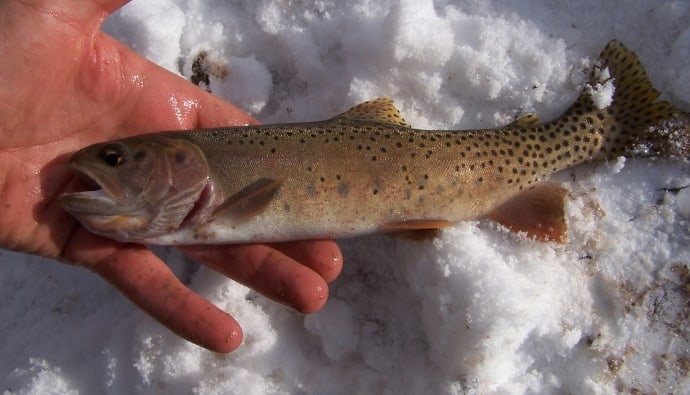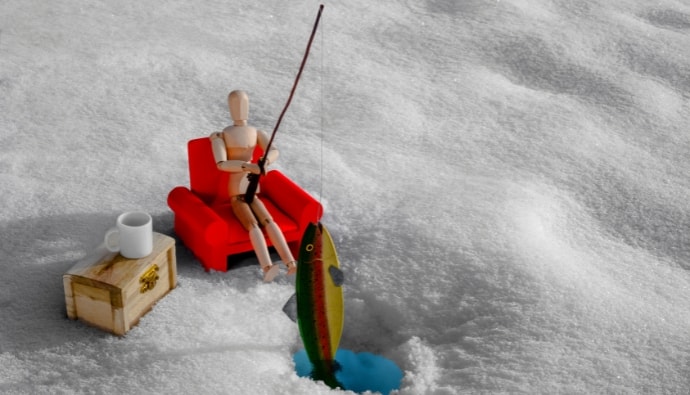If you target trout in your next ice fishing adventure, start by selecting a lake or river with large numbers of trout. Some famous rivers and lakes for trout ice fishing include St. Croix River, Lake Superior, Lake Granby, Crystal Lake, Lake Charlevoix, and Higgins Lake. Remember to carry an ice auger, a fishing rod, a reel, and a line specifically made for trout fishing. Trout species are attracted mainly by baits and lure such as wax worms, mealworms, and small jigging spoons. To increase the chances of catching trout, ensure you use specific baits and lures made for trout fishing. It’s also advisable to drill multiple holes. Always mind your safety by wearing warm clothes and checking the ice thickness before you start ice fishing for trout.
There are different trout species you can catch in the US waters. Most species caught in the northern lakes include the brook trout, brown trout, cutthroat trout, and rainbow trout. Here is a complete guide on ice fishing for trout and tips and tricks you can use to catch more ice fish under the ice successfully.

Best Places for Trout Ice Fishing
Plenty of rivers and lakes in the US hold trout all year round. Some of these lakes include:
1. Lake Superior
This lake offers excellent fishing opportunities to ice fishermen targeting lake trout. You can drill your hole anywhere as long as the water is 60 to 200 feet deep.
The most popular spot to drill your hole is along 21st Avenue East near Duluth. Also, you can follow Highway 61 north along the lake’s shoreline and find several spots for ice fishing.
2. Lake Charlevoix
The lake is located in Charlevoix County, Michigan, and offers a scenic environment for ice fishing. Because of its size, it takes a while to freeze, and you might have to wait until mid or late January to start ice fishing.
The lake has many fish species, including lake trout. Although you might catch small lake trout in the shallow water, it’s advisable to move to deeper water because that’s where enormous trout love to hide. Remember, these species are very aggressive, and you can use spinners, flutter spoons, or vertical jigging spoons to attract them.
3. Lake Granby
This lake is located in Colorado and is an excellent ice-fishing destination for anglers targeting lake and rainbow trout. Behind Lake Granby is Monarch Lake, which has plenty of rainbow and brook trout.
If you’re targeting the rainbows, cruise to the shallow water because they like living in shallower areas. You will have to go deeper if you target lake trout because they like living in deeper water, about 35 to 120 feet deep.
When fishing for trout here, ensure you use live bait like minnows, large bugs, and crawfish to attract them. You can also use small bright-colored jigs or spoons to induce a bite.
4. Crystal Lake
Crystal Lake is a large water body covering about 189 acres of surface. During winter, this lake attracts thousands of anglers targeting brown, rainbow, and brook trout.
You can use portable riggers and sliding hook rigs for your baitfish. Anglers prefer this technique because it’s easy to use and keeps your baitfish alive and moving naturally.
5. Higgins Lake
This lake is found in the Lower Peninsula. Higgins Lake has a massive shoreline home to popular species like walleye, bass, perch, and trout. Here, you’ll find public boats that you can use to access your fishing spot.
Equipment and Gear
Most trout species grow to more giant proportions, and it’s advisable to have a tackle that can withstand the weight of large fish. Some species, like the Rainbow trout, can achieve up to 40 inches in length.
If you’re a beginner and not used to ice fishing, you can use light ice fishing tackles but be sure you target smaller fish. The tackle you buy should be large and of good quality so that you won’t have problems when fishing.
Here is a list of ice fishing gear you need if your primary target is trout.
Reel
Ensure you invest in a good fishing reel. Ideally, your reel should have a size of at least 2000 to 3ooo reeling capacity.
If you’re planning to go fishing in deeper water, carry a little beefier reel because it allows extra line capacity. However, you might not need a reel with an additional capacity if you only target rainbow trout or brown trout.
Rod
When ice fishing for trout, you need a rod that is between 3 to 4 feet. You can use a standard ice fishing rod if you’re targeting smaller trout. However, bring along a strong fishing rod for catching lake trout because they’re heavy.
Fishing Line
Trout have excellent vision, and placing a thick fishing line can scare them away. Use an extra light line to increase the chances of inducing a bite. Don’t worry about your line breaking because fish is very light in water.
Ideally, invest in a 4 to 6-pound monofilament line if you’re targeting brown trout or rainbow trout. For larger species like the lake trout, use a 10 to 15-pound braided line. Always use braided lines over fluorocarbon and monofilament lines because they don’t stretch.
Ice Auger
The ice gets quite hard, and you will need an auger to drill holes. Invest in a good electric auger to help drill as many holes as possible.
Depth/Fish Finder
Instead of drilling holes randomly, it’s good to have a good depth and fish finder. There are many fish species in a lake, and these finders will help you locate where the trout are.
An Ice Shanty
When you decide to do ice fishing for trout, it’s advisable to have an ice shanty with a small propane heater to keep you warm as you wait to catch trout.
Tip Ups and Rod Bells
Sometimes, you need to drill and set multiple holes to increase the chances of catching a trout. It becomes hard to know when an ice fish bites, but this equipment will notify you when they detect a fish bite.
Other essential fishing gear to bring along include an ice cover, rod holders, shovels, buckets, chairs, a hot drink, and snacks.
Best Baits and Lures for Trout
Ice fishermen can use both artificial and live bait to attract trout. This is because trout remain active even in cold water and will take most of the bait you present to them.
Baits and Lures to Use for Trout Fishing
While other species get less active when the water temperatures decrease, the trout remain active even when it’s freezing. Some of the best natural baits and artificial lures include:
Minnows
Live minnows are perfect for catching trout. The minnows’ vibration and flash in the water column attract active trout from afar. Ensure you carry larger minnows if you target lake trout.
Salmon Eggs
This bait attracts these game fish because the eggs are bright and smelly. You can as well use artificial salmon eggs available in many tackle shops.
Nightcrawlers and Wax Worms
Nightcrawlers and wax worms are relatively passive natural baits, as you’re supposed to have a jigging rod to bring the trout closer to your bait.
Flutter Spoons
Most anglers prefer flutter spoons because they throw a lot of flashes in the water and don’t scare the ice fish away.
Marabou Jigs
Anglers prefer using them because they attract ice fish from deeper water. Ensure you use brighter colors at night and darker colors during the day to increase the chances of catching more fish.
Vertical Jigging Spoons
These shiny vertical spoons work best by attracting trout to your bait. It’s advisable to carry jigging spoons of different sizes and weights and see which attracts more fish.
Spinners
Spinners are excellent for ice fishing and work by causing vibrations that attract fish.
Jigs
You can increase your chances of catching trout by tipping tiny jigs with wax worms. Always carry a heavier jig if you plan to fish in deeper water or when the weather is rough.
Tips and Techniques for Catching Trout
To increase the chances of catching trout, you must deploy different ice fishing techniques because they rarely move in schools. Trout such as brown trout are usually found in relatively shallow areas and rarely move in deep water, especially during cold conditions.
You can use trial and error to locate trout, but you can also use a fish finder to make your work easier. The most preferred ice fishing techniques for trout are dead sticking, tip ups, and active jigging.
Active Jigging
Trout don’t move in schools and prefer wandering in a wide area. So, you attract them to your bait by jiggling actively. Jiggling sends a vibration into the water and draws trout miles away.
Dead Sticking
Trout are sensitive creatures and are usually scared away by noise. Dead sticking involves setting your baited fishing line on the rod and moving away. This reduces your chances of scaring them as they come towards your bait.
Ensure you put at least two rods to increase the chances of taking home a rainbow trout.
Tip Ups
You need a tip up to notify you when the fish bites. Tip ups are especially effective if you want to catch trout, especially lake trout, because they’re large enough to move the tip ups when they bite your bait.
How to Properly Handle and Release Trout
Anglers planning to do catch-and-release trout ice fishing should ensure they follow the recommended practices to increase their chances of survival. Some of these tips include:
Never place your fingers in the gills because they are delicate. Only put your fingers in the gills if you plan to kill it ethically.
Refrain from handling the trout with dry hands. Trout have a slime coating that dry hands can wipe. You can use specialized tailing to help you strengthen your grip.
Always use a barbless hook to limit the time you spend unhooking the fish. Barbed hooks can damage the gullet, thus increasing physical trauma and reducing the chances of survival when the fish is released back into the water.
Keep trout out of water for a short time.
Keep the trout in the water, and ensure the gills are submerged.
If you’re using a net, always use the rubberized net to help maintain the trout’s slimy coating.
Always scoop the fish using your hand to prevent harming or over-squeezing the fish.
Only play with the caught trout for a short time. Although watching fish move is fun, it can make the fish over-exhausted and fail to recover.
Following the guidelines above helps to increase the trout population in the rivers and lakes.
Here are more tips for catching trophy brown and rainbow trout! Watch the video below.
Conclusion
Trout are among the most popular fish targeted by anglers while fishing. The most famous rivers and lakes for trout fishing include St. Croix, Lake Superior, Crystal Lake, Lake Charlevoix, and Higgins Lake.
Remember to bring along an ice auger, a fishing rod, and a line made explicitly for trout fishing. Trout mostly move in shallow areas, and you can increase the chances of catching more fish by using live minnows, jiggling spoon, and spinners.
Follow the recommended practices and guidelines when releasing fish to increase the chances of ice fish survival. Ice fishing is fun, but remember to wear warm clothes and check the ice thickness before you start your fishing adventure.








 Facebook
Facebook YouTube
YouTube








